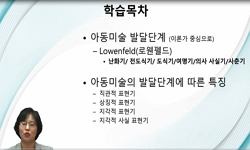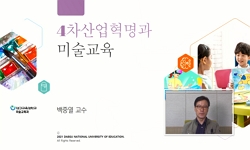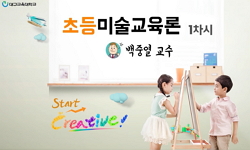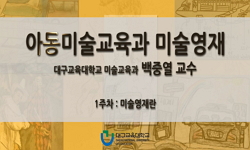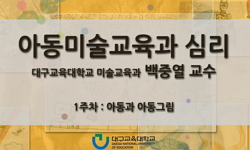오늘날 후기 산업사회에서의 상대성과 다원성을 강조하는 포스트모더니즘 문화의 유입은 미술과 장애에 대한 시각도 변모시켰으며 표현활동위주의 미술교육이 아닌 미술을 이해하고 즐기...
http://chineseinput.net/에서 pinyin(병음)방식으로 중국어를 변환할 수 있습니다.
변환된 중국어를 복사하여 사용하시면 됩니다.
- 中文 을 입력하시려면 zhongwen을 입력하시고 space를누르시면됩니다.
- 北京 을 입력하시려면 beijing을 입력하시고 space를 누르시면 됩니다.
장애아를 위한 『통합적 미술교육』 프로그램에 관한 연구 = A Study on Integrated Art Education Program for Children with Disabilities
한글로보기https://www.riss.kr/link?id=A75544235
- 저자
- 발행기관
- 학술지명
- 권호사항
-
발행연도
2008
-
작성언어
-
- 주제어
-
KDC
374.6705
-
자료형태
학술저널
-
수록면
1-25(25쪽)
- 제공처
-
0
상세조회 -
0
다운로드
부가정보
국문 초록 (Abstract)
오늘날 후기 산업사회에서의 상대성과 다원성을 강조하는 포스트모더니즘 문화의 유입은 미술과 장애에 대한 시각도 변모시켰으며 표현활동위주의 미술교육이 아닌 미술을 이해하고 즐기면서 자신이 살고 있는 시대와 문화의 흐름과 특징을 통찰하는 안목을 길러주는 교육, 미술 주변의 다른 학과들과의 연계된 학과간의 학습, 통합교육과정 등이 장려되고 있다. 그러나 현장의 교사들은 후기산업사회 에서의 미술교육 경향에 대한 인식이 부족하고, 교사들이 수행하고 있는 장애아 미술교육 또한 새로운 흐름을 반영하지 못하고 있는 실정이다. 이 연구는 이러한 상황을 극복하기 위하여 장애아 미술교육 실태와 문제점을 알아보고, 개선 방안을 제시 함으로써 장애아 미술교육의 새로운 방법을 모색하는 데 목적을 두고 있다. 현장에서 시행되고 있는 장애아미술교육의 실태를 조사하고 분석하기 위하여 유치부가 있는 전국 국공립 정신지체와 시각장애학교 62개교 77명의 교사를 대상으로 설문 조사하였으며 도출된 문제점에 대한 개선방안으로 미술과 음악, 문학, 신체표현, 연극 등 인접 예술 활동과의 통합교육, 미술과 사회ㆍ문화와의 통합교육을 제시하였다.
다국어 초록 (Multilingual Abstract)
The arts education is even more important subject for children with disabilities. Through the arts, the disabled children, whose curiosity and response to the surrounding objects and environments is slow and insignificant, are given motives to communi...
The arts education is even more important subject for children with disabilities. Through the arts, the disabled children, whose curiosity and response to the surrounding objects and environments is slow and insignificant, are given motives to communicate and ways to diversify feelings and ideas. That is, through the arts, children with disabilities can have feelings of being oneself and live their lives by themselves by combining subjects such as communicating, establishing relationship, values, self-reflections and self-esteem in a coordinated way. However, many people still take a modernism view that looks children with disabilities as special beings deviated from general, or beings not the same, rather than beings with individual characters and values who are just different. In this discriminative way of looking, most of arts educations for the disabled children aims at therapeutic aspects rather than aesthetic expression and enjoyment. For children with disabilities, however, arts have more meanings than therapeutic instruments. Arts have many aspects including therapeutic aspects. Arts help individuals to develop as a whole human being through integration of senses, integration of mind and body, integration of reason and emotion. And through arts, one is trained to view the life as a whole, to recognize the world correctly, which will lead to independent self-consciousness and eventually harmonious socialization. In spite that education for children with disabilities have to be equipped with both universality for the general education and particularity accommodating disabilities, arts education for children with disabilities and development of teaching methods are insufficient. This study attends to these problems at education field and recognizes that arts education for children with disabilities needs to integrate with other arts areas socially and culturally. Admitting post-modernism view of pluralistic and off-centered, and preceding researches about arts therapy for the disabled children, this study considered the integrated arts education program as more effective arts education method for children with disabilities as followings: first, this study drew problems of arts education by investigating and analyzing the reality of arts education for children with disabilities; second, in order to seek more effective arts education program, this study assessed strengths and weaknesses of the preceding cases which have tried to integrate near arts areas socially and culturally; third, this study originated and presented the integrated arts education program for children with disabilities. The principles of integrated arts education program for children with disabilities are set on education of multi-sensitivity, integration and structurism. And the purpose of the program is for the children with disabilities who are the learners to discover "me" whose body, mind and spirit are harmoniously integrated, and to develop abilities to freely express aesthetic experiences through communicating with objects they want to express and the world. The objectives of the program is as the followings: first, to develop cognitive abilities which will allow children with disabilities to perceive that the nature and other objects can be components of art; second, to cultivate abilities to feel and discover the beauty of inner world of themselves and outer world; third, to have the children with disabilities develop abilities to express their aesthetic ideas creatively. The contents of the program are suggested as integration of arts and near arts activities, integration of arts and social, cultural environments. The reason of suggesting integrated arts education program in this study is attributed to the idea that the integrated arts education will contribute to the disabled children`s ego formation and social integration. The arts education programs for children with disabilities which have been exercised at many schools have diverse proble
동일학술지(권/호) 다른 논문
-
- 한국달크로즈유리드믹스학회
- 성인지 ( In Ji Sung )
- 2008
-
유리드믹스와 음악교육 프로그램이 유아의 일상적 스트레스와 유치원 적응에 미치는 영향
- 한국달크로즈유리드믹스학회
- 최유정 ( You Jeong Choi )
- 2008
-
달크로즈 유리드믹스를 활용한 음악활동이 유아기 음악성 향상에 미치는 효과
- 한국달크로즈유리드믹스학회
- 최지원 ( Ji Won Choi )
- 2008
-
음악적 창의성 신장을 위한 초등학교 음악 수업의 개선 방안 -초등학교 3학년을 중심으로-
- 한국달크로즈유리드믹스학회
- 김효정 ( Hyo Jeong Kim )
- 2008




 KISS
KISS